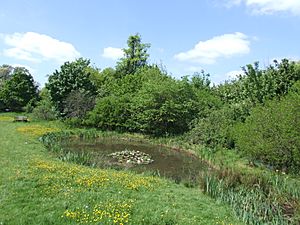Ali's Pond Local Nature Reserve facts for kids
Quick facts for kids Ali's Pond |
|
|---|---|
 |
|
| Type | Local Nature Reserve |
| Location | Sonnning, Berkshire |
| OS grid | SU 756 751 |
| Area | 0.4 hectares (0.99 acres) |
| Managed by | Friends of Ali’s Pond |
Ali's Pond is a special place in Sonning, Berkshire, where nature is protected. It's a small area, about the size of half a football field (0.4 hectares or 1 acre), that has been officially named a Local Nature Reserve. This means it's a safe home for many plants and animals. The local council, Sonning Parish Council, owns it, and a group called the Friends of Ali's Pond helps look after it.
Contents
Discovering Ali's Pond
Ali's Pond is right next to King George's Field in Sonning. It was created in 1997 by a local expert named Alastair Driver. He is an ecologist, which means he studies how living things interact with their environment. The pond is named after him! Alastair also volunteers to look after the area. The reserve has clear paths and several large ponds for everyone to enjoy.
Becoming a Nature Reserve
Something exciting happened in the summer of 2000 during a "pond-dipping" event at the Millennium Festival. People found Great Crested Newts living in the pond! These newts are a special and protected type of amphibian. Because of this important discovery, an application was made to English Nature (a government group that protects nature) to make Ali's Pond an official Local Nature Reserve.
Official Recognition
The first plan to manage the site was made in September 2000. Then, in April 2001, Ali's Pond was officially declared a Local Nature Reserve. This was a big deal because Sonning Parish Council became only the third parish council in the whole country to have its own nature reserve!
Wildlife at Ali's Pond
Ali's Pond was created and is managed so that everyone in the local community and visitors can enjoy nature. It's a fantastic place to see different kinds of wildlife.
Amazing Animals and Plants
Many important species have made Ali's Pond their home. These include:
- The Great crested newt
- The Stag beetle
- The Song thrush (a type of bird)
- The Pipistrelle bat
Since 1997, people have recorded over 18 different types of dragonflies, more than 250 kinds of larger moths, and over 40 species of water and wetland plants at the site. It's like a living outdoor classroom!
Expanding Nature's Home
In 2006, the field next to Ali's Pond was bought by Reading Blue Coat School. A year later, in 2007, a new nature area was created within this field. This was done to provide even more habitat for the Great Crested Newts.
Sonning Field: A New Habitat
This new area is called Sonning Field. It has another pond where amphibians can breed, plus piles of logs and brushwood. These piles offer great hiding places and homes for small animals. New hedgerows with many different native trees and shrubs were also planted. There's a path that lets you easily walk from Ali's Pond through Sonning Field and on to Sonning Lane.
Community Involvement
Ali's Pond is not just a place to visit; it's also a place where people can get involved. The Friends of Ali's Pond (FAP) Group helps look after the reserve.
The Friends of Ali's Pond
The FAP group has over 60 members, most of whom live very close to the reserve. These volunteers help with many important tasks, such as:
- Planting trees
- Clearing the ponds
- Making hay
They also join in surveys to count moths and amphibians, guided by the voluntary warden, Alastair Driver. Their conservation work isn't just limited to the reserve itself. They also help with nature projects in other nearby areas to create even more good habitats for wildlife.
Award-Winning Efforts
In 2016, the Friends of Ali's Pond received a special award from the Chartered Institute of Ecology and Environmental Management. It was the Best Practice Award for Practical Nature Conservation - Small Scale, recognizing their excellent work in protecting nature.

